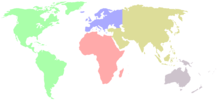Four continents

Europeans in the 16th century divided the world into four continents: Africa, America, Asia and Europe.[1] Each of the four continents was seen to represent its quadrant of the world—Europe in the north, Asia in the east, Africa in the south, and America in the west. This division fit the Renaissance sensibilities of the time, which also divided the world into four seasons, four classical elements, four cardinal directions, four classical virtues, etc.
The four corners of the world refers to the America (the "west"), Europe (the "north"), Asia (the "east"), and Africa (the "south").
A three-cornered world
Before the discovery of the New World a commonplace of classical and medieval geography had been the "three parts" in which, from Mediterranean and European perspectives, the world was divided: Europe, Asia and Africa. As Laurent de Premierfait, the pre-eminent French translator of Latin literature in the early fifteenth century, informed his readers:
Asia is one of the three parts of the world, which the authors divide in Asia, Africa and Europe. Asia extends towards the Orient as far as the rising sun ("devers le souleil levant"), towards the south ("midi") it ends at the great sea,[2] towards the occident it ends at our sea, and towards the north ("septentrion") it ends in the Maeotian marshes and the river named Thanaus.[3]
A fourth corner: the enlarged world
For Laurent's French readers, Asia ended at "our sea", the Mediterranean; Europeans were only dimly aware of the Ural Mountains, which divide Europe from Asia in the eyes of the modern geographer, and which represent the geological suture between two fragmentary continents, or cratons. Instead, the division between these continents in the European-centered picture was the Hellespont, which neatly separated Europe from Asia. From the European perspective, into the Age of Discovery, Asia began beyond the Hellespont with Asia Minor, where the Roman province of Asia had lain, and stretched away to unimaginably exotic and distant places— "the Orient".
In the sixteenth century America too was full of exotic promise: the "New World".[4]
In 1603, Cesare Ripa published a book of emblems for the use of artists and artisans who might be called upon to depict allegorical figures. He covered an astonishingly wide variety of fields, and his work was reprinted many times. It was still being brought up-to-date in the 18th century. The illustrations reveal fixed Eurocentric perceptions of the nature of the "four corners of the world." Ripa's Europe (illustration, left) is the land of abundance (cornucopia) of kings and the pope, whose crowns and the papal tiara lie at her feet, and of cities.
Africa, by contrast (illustration, below right) wears the elephant headdress (worn by rulers depicted on Hellenistic Bactrian coins) and is accompanied by a lion, the scorpion of the desert sands and Cleopatra's asps. Asia (illustration, right), the seat of Religion, carries a smoking censer as a camel takes its ease.
And the iconic image of America (illustration, below left) shows a Native American maiden in a feathered headdress, with bow and arrow. Perhaps she represents a fabled Amazon from the river that already carried the name.
The American millionaire philanthropist James Hazen Hyde, who inherited a majority share in Equitable Life Assurance Society, formed a collection of allegorical prints illustrating the Four Continents that are now at the New-York Historical Society; Hyde's drawings and a supporting collection of sets of porcelain table ornaments and other decorative arts illustrating the Four Continents were shared by various New York City museums.
The Renaissance associated one major river to each of the continents. The Four Rivers theme appears for example in the Fontana dei Quattro Fiumi in the Piazza Navona in Rome.
With the confirmed discovery that Australia was an island continent, the theme of the "Four Continents" lost much of its drive, long before a sixth continent, Antarctica, was discovered. The iconography survived as the Four Corners of the World, however, generally in self-consciously classicizing contexts: for instance, in New York, in front of the Beaux-Arts Alexander Hamilton U.S. Custom House (1907), four sculptural groups by Daniel Chester French symbolize the "Four Corners of the World."
Notes
- ↑ Nothing was known of Australia, first sighted in the early seventeenth century, or Antarctica, first sighted in the nineteenth century.
- ↑ The Pacific Ocean was not yet known to Europeans; a conjectured "South Sea" south of Africa would be part of the Southern Ocean of modern geography.
- ↑ Asie est l'une des trois parties du monde que les auteurs divisent en Asie, Afrique et Europe. Asie se extend devers orient jusques a souleil levant, devers midi elle fine a la grant mer devers occident elle fine a notre mer, et devers septentrion elle fine aux paluz Meotides et au fleuve appellé Thanaus; Laurent de Premierfait's expanded translation of Boccaccio's De Casibus Virorum Illustrium (1409), quoted in Patricia M. Gathercole, "Laurent de Premierfait: The Translator of Boccaccio's De casibus virorum illustrium" The French Review 27.4 (February 1954:245-252) p. 249.
- ↑ This theme is extensively explored in Hugh Honour, The New Golden Land: European Images of America from the Discoveries to the Present (1975).
See also
References
- Honour, Hugh, The New Golden Land: European Images of America from the Discoveries to the Present Time. New York: Pantheon Books, 1975. An exhibition based on the book's premise was curated by Honour at the Cleveland Museum of Art, 1975-77.
- Le Corbeiller, Clare, "Miss America and Her Sisters, Personifications of the Four Parts of the World," Bulletin of the Metropolitan Museum of Art (Apr. 1961): 209-23.
- Fleming, E. McClung, "The American Image as Indian Princess, 1765-1783," Winterthur Portfolio 2 (1965): 65-81.
- Fleming, E. McClung, "From Indian Princess to Greek Goddess: The American Image, 1783-1815," Winterthur Portfolio 3 (1967): 37-66.
- Higham, John, "Indian Princess and Roman Goddess: The First Female Symbols of America," Proceedings of the American Antiquarian Society 100(1) 45-79: 1990